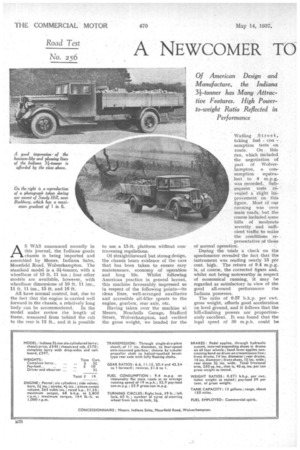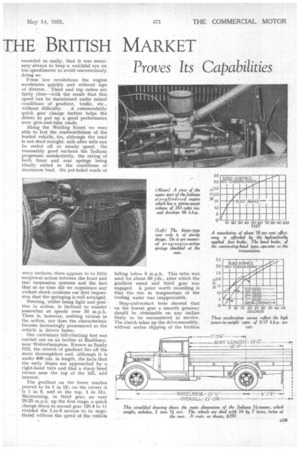NEWCOMER TO THE BRITISH MARKET
Page 38

Page 39

Page 40

If you've noticed an error in this article please click here to report it so we can fix it.
Proves Its Capabilities AS WAS announced recently in this journal, the Indiana goods chassis is being imported and assembled by Messrs. Indiana Sales, Moorfield Road, Wolverhampton. The standard model is a 3i-tonner, with a wheelbase of 13 ft. ii ins. ; four other models are available, however, with wheelbase dimensions of 10 ft. 11 ins., 11 ft. 11 ins., 15 ft. and 16 ft.
All have normal control, but, due to the fact that the engine is-carried well forward in the chassis, a relatively long body can be accommodated. In the model under review the length of -frame, measured from behind the cab to the rear is 12 ft., and it is possible
to use a 13-ft. platform without contravening regulations.
Of straightforward but strong design, the chassis bears evidence of the care that has been taken to ensure easy maintenance, economy of operation and long life. Whilst following American practice. in general layout, this machine favourably impressed us in respect of the following points—its clean lines, well-arranged auxiliaries and accessible oil-filler spouts to the engine, gearbox, rear axle, etc.
Having taken over the machine at Messrs. NeacheIls Garage, Stafford Street, Wolverhampton, and verified the gross weight, we headed for the
Watling Streets taking fuel con sumption tests en route. On this run, which included the negotiation of part of Wolverhampton, a consumption equivalent to 9 m.p.g. was .recorded. Subsequent tests revealed a slight iinproveraent on this figure. Most of our running was over main roads, but the course included some hills of moderato severity and -sufficient traffic to make the conditions representative of those of normal operation.
During the trials a check on the speedometer revealed the fact that the instrument was reading nearly 15 per cent. high. The return of 9.4 m.p.g. is, of course, the corrected figure and, whilst not being noteworthy in respect of economical running. it may be regarded as satisfactory in view of the good all-round performance the Indiana possesses.
The ratio of 0.57 b.h.p. per cwt. gross weight, affords good acceleration on. level ground, and it follows that the hill-climbing powers are proportionately excellent, It was found that the legal speed of 20 m.p.h. could be
exceeded so easily, that it was necessary always to keep a watchful eye on the speedometer to avoid unconsciously doing so.
From low revolutions the engine accelerates quickly and without sign of distress. Third and top ratios are fairly close—with the result that this speed can be maintained under mixed conditions of gradient, traffic, etc„ without difficulty. A commendably quick gear change further helps the driver to put up a good performance over give-and-take roads.
Along the Watling Street we were able to test the roadworthiness of the loaded vehicle, for, although the road is not dead straight, mile after mile can be reeled off at steady speed. On reasonably good surfaces the Indiana progresses satisfactorily, the rating of both front and rear springs being ideally stilted to the conditions of maximum load. On pot-holed roads or wavy surfaces, there appears to be little reciprocal action between the front and rear suspension systems and the fact that at no tune did we experience any violent shock confirms our first impression that the springing is well arranged.
Steering, whilst being light and positive in action, is inclined to wander somewhat at speeds over 30 m.p.h. There is, however, nothing vicious in the action, nor does the characteristic become increasingly pronounced as the vehicle is driven faster.
Our customary hill-climbing test was carried out on an incline at Bushbury, near Wolverhampton. Known as Sandy Hill, the stretch of gradient lies off the main thoroughfare and, although it is under 400 yds. in length, the facts that the early slopes are approached by a right-hand turn and that a sharp bend occurs near the top of the hill, add interest.
The gradient on the lower reaches proved to be 1 in 19; on the corner it is 1 in 8, and at the top, 1 in 111. Maintaining, in third gear, an easy 20-25 m.p.h. up the first stage, a quick change down to second gear (20.4 to ) enabled the 1-in-8 section to he negotiated without the speed of the vehicle
falling below 8 m.p.h. This ratio was used for about 50 yds., after which the gradient eased and third gear was engaged. A point worth recording is that the rise in temperature of the cooling water was inappreciable.
Stop-and-restart tests showed that on the lowest gear a smooth getaway should be obtainable on any incline likely to be encountered in service. The clutch takes up the drive smoothly, without undue slipping of the friction
surfaces, the pedal action being easy and not unduly sensitive.
As will be seen from the accompanying braking graph, the retardation afforded by the hydraulic brakes is satisfactory. Consisting of a contracting band on a drum behind the gearbox, the hand system is not suitable for use in normal service, although it is entirely serviceable as a parking brake.
In addition to the attractive features of the chassis outlined earlier, the particularly clean lines of the engine deserve mention ; the ignition distributor and water pump are housed on the near side of the crankcase, whilst the valves, the inlet and exhaust manifolds and the Zenith downdrairght carburet
ter are grouped on the off side. The manifolding is especially simple, as the two pipes are of rectangular section, the three inlet branches covering " Siamesed " ports and the four exhaust branches lying neatly hnmediately beneath the other manifold.
Full equipment is provided, which includes a six-volt electric set.




















































































